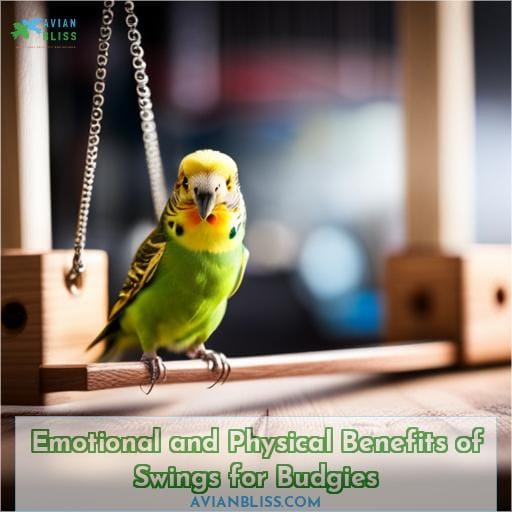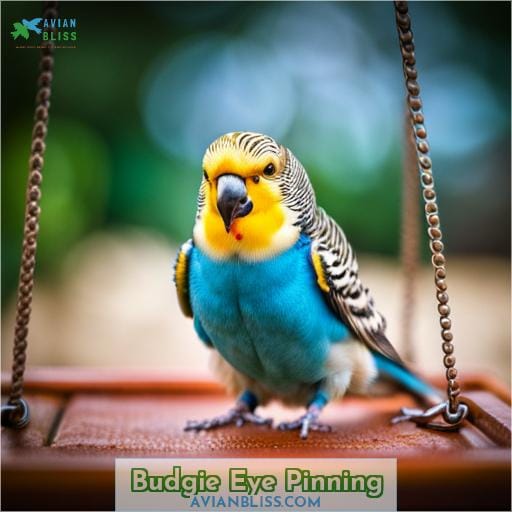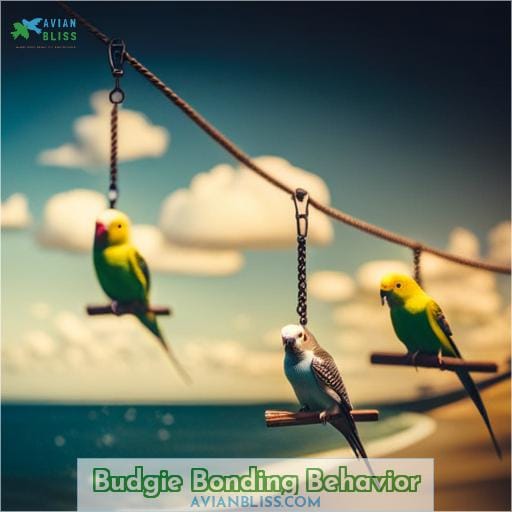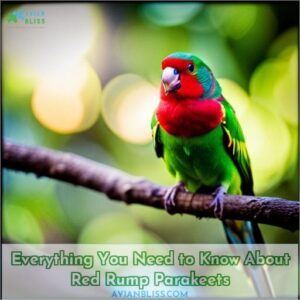This site is supported by our readers. We may earn a commission, at no cost to you, if you purchase through links.
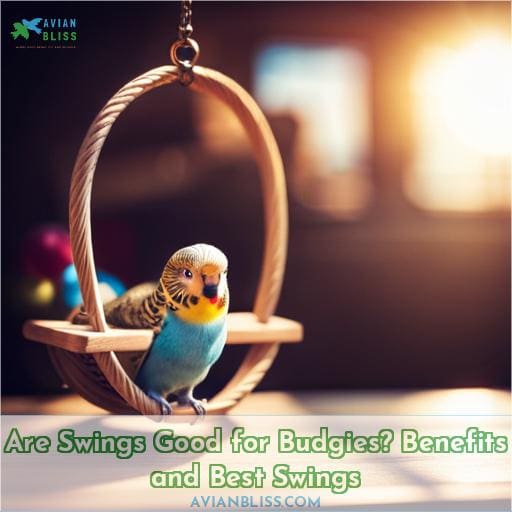 Imagine watching your budgie joyfully swing back and forth, chirping with delight. Swings are not just a simple toy for budgies; they offer numerous benefits to their emotional and physical well-being.
Imagine watching your budgie joyfully swing back and forth, chirping with delight. Swings are not just a simple toy for budgies; they offer numerous benefits to their emotional and physical well-being.
In this article, we will explore why swings are good for budgies and discuss the best options available in the market. So if you want to provide your feathered friend with hours of entertainment and enrichment, keep reading! Your budgie will thank you for it.
Table Of Contents
- Key Takeaways
- Emotional and Physical Benefits of Swings for Budgies
- Best Swings for Budgies
- Buyer’s Guide: Choosing a Swing for Your Budgie
- Are Swings Good for Budgies? Explained
- Types of Budgie Toys
- Budgie Playing With Toys
- Budgie Eye Pinning
- Budgie Bonding Behavior
- Budgie Preening or Grooming
- Frequently Asked Questions (FAQs)
- How often should I rotate or replace budgie swings and toys?
- What size swing should I get for my budgie based on their size?
- Are rope or wood swings better for budgies? What are the pros and cons of each?
- Can I make homemade budgie swings and toys? What materials are safe to use?
- Where should I position the swing in the cage for optimal use? How high should it be placed?
- Conclusion
Key Takeaways
- Swings provide exercise and prevent boredom, promoting both emotional and physical well-being.
- Budgies love to swing back and forth, which stimulates mental activity and encourages socialization with other birds.
- Swinging also promotes good beak health as budgies can use their beaks to grip onto the swing.
- Choosing the right size swing and considering interactive features can enhance the benefits of swings for budgies.
Emotional and Physical Benefits of Swings for Budgies
As a budgie owner, you may be wondering about the emotional and physical benefits of swings for your feathered friend.
Swings play a crucial role in providing both entertainment and interaction for budgies, who are social birds by nature.
Not only do swings allow them to exercise and have fun, but they also promote social development as budgies can interact with each other while enjoying their swinging activities.
Emotional Importance
Swings are good for budgies because they provide exercise and prevent boredom, promoting both emotional and physical well-being.
Budgies love to swing back and forth, which stimulates mental activity and encourages socialization with other birds.
Swinging also promotes good beak health as budgies can use their beaks to grip onto the swing.
It’s a great way for your feathered friend to bond with you and enjoy the freedom of flapping its wings while having fun on the swing.
Physical Importance
To keep your budgie physically healthy and entertained, it’s important to provide them with swings that encourage exercise and movement.
Swings not only prevent boredom but also promote good beak health by providing a surface for chewing.
They encourage exercise, improve overall well-being, and provide mental stimulation for your budgie.
Whether it’s a swing, perch or ladder, these accessories are essential in ensuring that your feathered friend stays active and happy.
Best Swings for Budgies
When choosing a swing for your budgie, it’s important to consider the size of your bird and the dimensions of the swing.
Some popular options include:
- HONBAY Wooden Bird Swing Perch
- JW Pet Insight Sand Perch Swing Bird Toy
- ESRISE 8 Pcs Bird Parrot Toys
- Wontee Bird Triangle Rope Swing
- Prevue Hendry Naturals Rope Ladder
These swings offer a variety of features such as colorful beads and bells or natural materials like wood and sand perches to keep your budgie entertained while providing exercise and stimulation.
HONBAY Wooden Bird Swing Perch
Now let’s delve into the best swings for budgies, starting with the HONBAY Wooden Bird Swing Perch.
Made from durable and long-lasting natural wood, this swing isn’t only safe for budgies but also provides a comfortable perch for them to relax and play on.
The wooden material makes it easy to clean, ensuring hygiene in your bird’s cage.
With its sturdy construction, the HONBAY Wooden Bird Swing Perch is an excellent choice for your budgie’s entertainment needs.
JW Pet Insight Sand Perch Swing Bird Toy
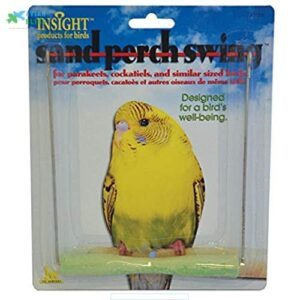
You’ll love the JW Pet Insight Sand Perch Swing Bird Toy for your budgie’s swinging needs. This swing is specially designed to provide both physical and mental stimulation for your feathered friend.
The natural sand coating on the perch helps keep your budgie’s nails filed smooth, while the varied widths of the swing resemble their natural habitat and prevent sore feet. It’s a durable yet comfortable option that will keep your budgie entertained and active.
- Natural sand coating keeps nails filed smooth
- Varied widths resemble natural habitat
- Durable construction
- Some customers reported that it can be rough on their bird’s feet, requiring additional padding or wrapping
- One side of the swing may be sturdier than the other
ESRISE 8 Pcs Bird Parrot Toys
Next, let’s talk about the ESRISE 8 Pcs Bird Parrot Toys, which are among the best swings for budgies.
These colorful and durable toys provide hours of fun and entertainment for your feathered friend. They feature beads, bells, and interactive elements that engage your budgie’s natural curiosity.
With these swings in their cage or aviary, your budgie can enjoy swinging back and forth while stimulating their physical activity and mental well-being.
Wontee Bird Triangle Rope Swing
The Wontee Bird Triangle Rope Swing is an excellent choice for budgies looking for a fun and engaging swing option.
Made of durable rope material, this swing can withstand the weight of your budgie while providing a safe and secure perch.
Its triangle shape adds stability, allowing your budgie to confidently hop on and enjoy swinging back and forth.
With its vibrant colors and pattern, the Wontee Bird Triangle Rope Swing won’t only entertain your budgie but also add visual appeal to their cage.
Plus, it offers great value at an affordable price point.
Prevue Hendry Naturals Rope Ladder
For the best swings for budgies, consider the Prevue Hendry Naturals Rope Ladder.
This swing is made from natural rope materials that are safe and durable for your budgie to play on.
The ladder design allows your bird to climb and swing, providing both physical exercise and mental stimulation.
It’s lightweight yet sturdy enough to support the weight of a budgie without any safety concerns.
With its affordable price, this swing is an excellent choice for enhancing your budgie’s cage environment.
Buyer’s Guide: Choosing a Swing for Your Budgie
When choosing a swing for your budgie, there are several important factors to consider.
First, make sure the size of the swing is appropriate for your bird’s comfort and safety.
Outdoor portable swings can provide additional stimulation and enrichment for your budgie.
Lastly, look for interactive features such as bells or beads that can engage your bird and keep them entertained while using the swing.
Swing size for budgies
When choosing a swing for your budgie, consider the appropriate size.
Budgies need swings that are suitable for their size and provide enough space for them to comfortably perch and swing.
- 3-4 inches in width for small budgies
- 6-8 inches in width for medium-sized budgies
- 9-12 inches in width for larger or more active budgies
- 12–14+ inches in width if you have multiple budgies who like to share a swing.
Make sure the swing fits well within your bird’s cage without overcrowding it.
Outdoor portable swings
If you’re considering an outdoor portable swing for your budgie, there are a few important factors to keep in mind.
First, consider the size of the swing and whether it can comfortably accommodate your bird’s weight.
Look for durable materials that can withstand outdoor conditions.
Make sure the swing attachment is secure and suitable for your cage type.
Lastly, prioritize safety features such as non-toxic materials and smooth edges.
Consider both price and value when making your final decision on an outdoor portable swing for your budgie.
Interactive swing features
Now let’s explore the interactive features that you should consider when choosing a swing for your budgie.
- Look for swings that provide a smooth swinging motion to mimic their natural movement in the wild.
- Consider options with bells attached, as the ringing sound can engage and stimulate your budgie.
- Ensure that the perch size is appropriate for their feet and provides comfort while they swing.
- Opt for swings made of safe rope material, and look for additional interactive elements such as chewable toys, mirrors, puzzle toys, ball toys, or shreddable toys to keep your budgie entertained during playtime on the swing.
Are Swings Good for Budgies? Explained
Swings are indeed good for budgies, as they provide both emotional and physical benefits to your feathered friends.
Budgies love to stretch their wings on swings, which helps them exercise and maintain healthy wing muscles. It also allows them to engage in natural behaviors like head bobbing while perched on the swing.
Swings provide a source of entertainment and mental stimulation for budgies, keeping them engaged and preventing boredom. Additionally, if your budgie is obsessed with a bell toy, having a swing with bells can satisfy their desire for auditory stimulation while providing exercise at the same time.
So not only do swings enhance your budgie’s overall well-being by promoting physical activity but they also contribute to their emotional fulfillment by stimulating natural behaviors.
Types of Budgie Toys
As a budgie owner, it’s important to provide your feathered friend with a variety of toys for both physical and mental stimulation.
Swings are just one type of toy that can benefit your budgie’s overall well-being.
- paper-based shreddable toys fulfill their natural chewing instincts,
- perches and ladders keep them active,
- chew toys promote good beak health,
- bells stimulate their auditory senses,
- puzzle toys challenge their intelligence,
- mirrors provide companionship and entertainment.
Swings
When it comes to providing enrichment and entertainment for your budgie, one essential type of toy to consider is the swing.
Swings offer a variety of benefits for budgies, including physical exercise and mental stimulation.
They come in different types such as wooden swings with ropes or rope perch swings, allowing your budgie to climb and swing simultaneously.
Choose the right size swing that ensures safety for your feathered friend while offering them hours of enjoyment.
Paper-Based, Shreddable Toys
If you want to provide your budgie with a toy that satisfies their need to chew and shred, paper-based shreddable toys are an excellent option.
These toys not only fulfill the budgies’ need to chew, but they also keep them active and promote better foot health. Additionally, paper-based shreddable toys stimulate the budgies’ auditory senses as they interact with the crinkling sounds of the paper.
They provide physical activity while keeping your budgie entertained for hours on end.
| Paper-Based Shreddable Toys |
|---|
| Benefits |
| – Fulfill chewing needs |
| – Promote foot health |
| – Stimulate auditory senses |
Perches and Ladders
As your budgie explores various types of toys, it’s important to consider the benefits of perches and ladders.
- Natural perches promote foot health, while wooden perches contribute to good beak health.
- Rope perches help with climbing, and ladder perches provide exercise for your budgie.
Incorporating these different types of toys into their environment, such as bird playgrounds with a variety of enrichment activities like swings, can create a stimulating and engaging space for your feathered friend.
Chew Toys
Now let’s explore the importance of chew toys for your budgie’s mental stimulation and beak health.
Chew toys are essential for budgies as they provide both entertainment and help maintain their beak health.
There are various types of chew toys available, such as bird-safe wooden blocks, which prevent boredom and satisfy their curiosity.
These toys offer benefits like preventing feather plucking by redirecting their chewing behavior.
Alternatives to chew toys include foraging toys or plush toys that can also engage them mentally while providing comfort and companionship.
Bells
Budgies enjoy playing with bells as they provide auditory stimulation and entertainment.
When a bell makes noise, it captures their attention and triggers eye pinning, an indication of excitement.
Budgies love to tap the bell with their beaks or swing it back and forth, creating a delightful sound that keeps them engaged.
Bells quickly become a favorite toy for budgies due to the combination of visual and auditory stimuli they provide.
- Engaging in play by tapping the bell
- Swinging the bell back and forth
- Enjoying the sound produced by the moving bells
- Obsession with interacting with bells as toys
-Bells triggering eye pinning in budgies
Puzzle Toys
To engage your budgie’s intelligence and provide mental stimulation, puzzle toys are a great option.
These types of toys come in various forms and offer numerous benefits for your budgie.
Puzzle toys promote problem-solving skills, enhance cognitive abilities, and prevent boredom.
They encourage physical activity as well as mental engagement.
When choosing puzzle toys for your budgie, ensure they’re safe with no small parts that could be swallowed or pose a choking hazard.
Puzzle toys designed specifically for parrots can also be suitable for budgies.
Mirrors
As you explore different types of budgie toys, mirrors are another popular option that can provide your budgie with a sense of companionship and entertainment.
Mirrors help break the ice between birds by providing a reflection that they can interact with. Budgies may exhibit eye pinning behavior when observing themselves in the mirror, which indicates their interest and engagement.
Additionally, mirrors can help alleviate obsessive bell ringing behaviors and provide an opportunity for scratching needs to be met.
Foraging Toys
To provide mental and physical stimulation for your budgies, consider incorporating foraging toys into their cage setup.
These toys not only help budgies exercise but also allow them to learn and engage in their natural behavior of finding food.
Foraging toys provide a fun and interactive way for budgies to stay mentally stimulated, promoting good mental health.
So go ahead and add some exciting foraging toys to keep your budgie happy and active!
Ball Toys
Next, let’s explore the fun and exciting world of ball toys for budgies.
Ball toys are a great addition to your budgie’s toy collection. They provide hours of entertainment and stimulation for your feathered friend.
These toys are easy to clean, chewable, and come in various colors that capture the attention of your budgie.
Watching them play with these colorful balls will surely bring joy to both you and your pet bird!
Chimes
Now let’s move on to chimes, which are another type of toy that can provide auditory stimulation and improve your budgie’s overall well-being.
Chimes are good for budgies because they offer a fun and interactive experience. Budgies enjoy the sound produced by chimes, which can bring them joy and happiness.
Chimes are safe for budgies as long as they’re made from bird-safe materials and have no small parts that could be swallowed.
Bird Playgrounds
As you explore the world of budgie toys, don’t forget to consider bird playgrounds as a fun and engaging option for your feathered friend’s entertainment.
Bird playgrounds come in various sizes, materials, and types to suit your budgie’s needs. These play structures provide a safe environment for exercise and mental stimulation while promoting natural behaviors like climbing, swinging, and exploring.
With proper size considerations and safety precautions in place, bird playgrounds offer numerous benefits for your budgie’s overall well-being.
Plush Toys
You’re right – plush toys can also provide mental stimulation and companionship for budgies.
They’re especially helpful for single birds who may feel lonely without a flockmate to bond with.
Plush bird toys typically come shaped like small birds or animals and can bring comfort when a budgie needs a snuggly companion.
These toys provide comfort, prevent loneliness, reduce boredom, stimulate curiosity, and encourage bonding in budgies.
Budgie Playing With Toys
When it comes to budgies playing with toys, they can provide hours of entertainment and stimulation for your feathery friend. Budgies have natural behaviors such as chewing, yawning, scratching, eye pinning, and wing stretching that are all part of their playtime routine.
Playing with toys allows budgies to engage in these activities while keeping them mentally and physically active.
Here are some ways your budgie can enjoy playing with toys:
- Chewing Toys: Budgies love to chew on things like wooden blocks or balsa wood.
- Yawning: Yawning is a sign that your budgie is tired and getting ready for sleep.
- Scratching: If you notice your budgie scratching itself using its foot or on a toy or perch, it’s just grooming itself.
- Eye Pinning: Eye pinning occurs when the pupils dilate rhythmically as the bird focuses on an interesting object.
Playing with toys not only keeps them entertained but also helps fulfill their natural instincts for exploration and engagement in stimulating activities!
Budgie Eye Pinning
Since playing with toys can trigger ‘eye pinning’ in budgies, you’re observing their pupils dilating and contracting rhythmically when they focus intently on an interesting object or a mate they’re about to feed.
As an experienced bird owner, you know this eye pinning indicates intense focus and interest. The pupils’ rhythmic dilation and contraction may last several seconds as your budgie inspects a new toy or stares lovingly at its chosen mate.
Eye pinning is an involuntary response showing that your budgie’s full attention is captivated. While harmless, eye pinning’s intensity and duration can reveal much about what engages your budgie’s curiosity and companionship needs.
Providing toys that trigger this response brings your budgie joy. For solitary budgies, eye pinning directed at a mirror or favorite toy may signal a need for a living companion.
Much can be learned from observing your budgie’s eye pinning behavior.
Budgie Bonding Behavior
As budgies are social creatures, they naturally engage in bonding behavior with their flock mates.
Budgie bonding involves activities such as mutual grooming, which helps strengthen the bond between birds and promotes a sense of intimacy within the flock.
Another way budgies bond is through play and interaction with toys, including swings. Swings provide an opportunity for birds to exercise together while also stimulating their natural chewing instincts.
Chewing on swing ropes or perches can help maintain beak health by keeping them trimmed and preventing overgrowth. Additionally, swinging movements can induce relaxation in budgies, leading to yawning behaviors that signify contentment and comfort within their social group.
Incorporating a mirror into the cage environment may further enhance bonding by providing companionship for lone birds or triggering curiosity and engagement among flock members.
Budgie Preening or Grooming
During their bonding behavior, budgies engage in mutual preening or grooming to help maintain cleanliness and care for hard-to-reach areas.
You’ll notice your budgies preening each other, using their beaks and tongues to align feathers and remove debris. This mutual preening helps them scratch areas they can’t reach themselves, like their heads and necks.
Since budgies can’t reach their own faces, mutual preening assists with grooming those hard-to-reach spots.
Budgies also love to chew things as part of their natural behavior. Provide plenty of safe chew toys in their cage to satisfy this urge.
Observing your budgies’ mutual preening and chewing behaviors provides insight into their needs for social bonding and mental stimulation.
Frequently Asked Questions (FAQs)
How often should I rotate or replace budgie swings and toys?
To ensure your budgie stays engaged and stimulated, it’s recommended to rotate or replace their swings and toys every few weeks.
This keeps things fresh and exciting for them, promoting their overall well-being.
What size swing should I get for my budgie based on their size?
Choose a swing size for your budgie based on their size.
A small swing is suitable for budgies around 4-6 inches in length, while a larger swing is better for those above 7 inches.
Are rope or wood swings better for budgies? What are the pros and cons of each?
Both rope and wood swings have great benefits for your budgie.
Rope swings allow for more chewing which is fantastic for beak health.
Wood swings provide stable perching to swing and climb, promoting agility.
I recommend providing both types of swings to nurture your budgie’s mind and body!
Can I make homemade budgie swings and toys? What materials are safe to use?
To make homemade budgie swings and toys, use safe materials like untreated wood or natural fibers.
Avoid using toxic substances or small parts that could be swallowed.
Get creative and provide your budgie with engaging and stimulating DIY options for playtime!
Where should I position the swing in the cage for optimal use? How high should it be placed?
To position the swing optimally in your budgie’s cage, place it at a height where they can easily hop on and off.
Imagine their joy as they soar through the air, feeling liberated and empowered by their newfound play space.
Conclusion
You’re absolutely right to provide your budgie with a swing.
Swings offer vital physical and emotional enrichment for our feathered friends.
Choosing the right size swing and interactive features promotes healthy exercise and bonding.
Watching your budgie happily swing and play is a joy.
Prioritize swings and toys – the benefits of stimulation and activity for budgies are clear.
Trust me, swings are good for budgies explained!

